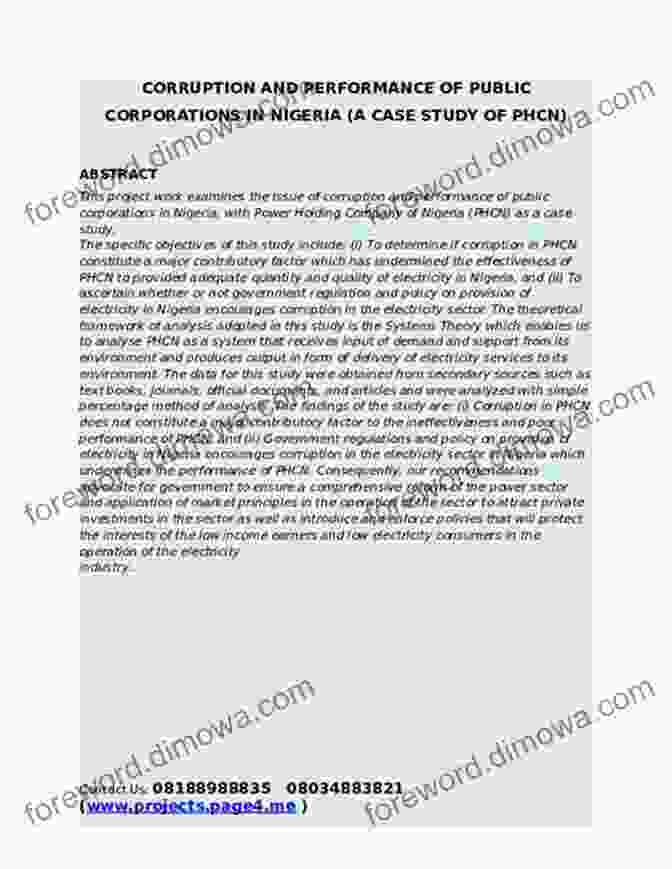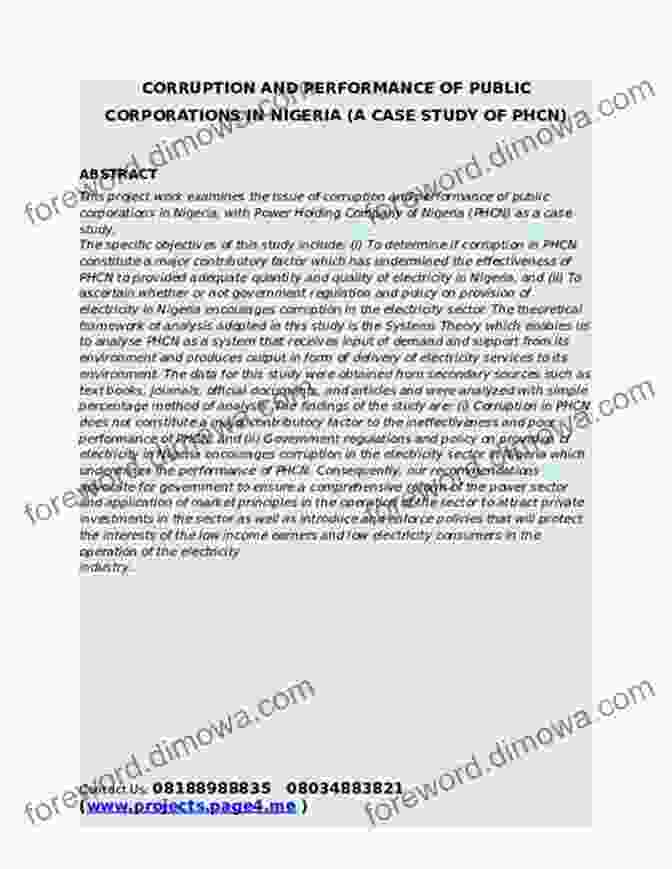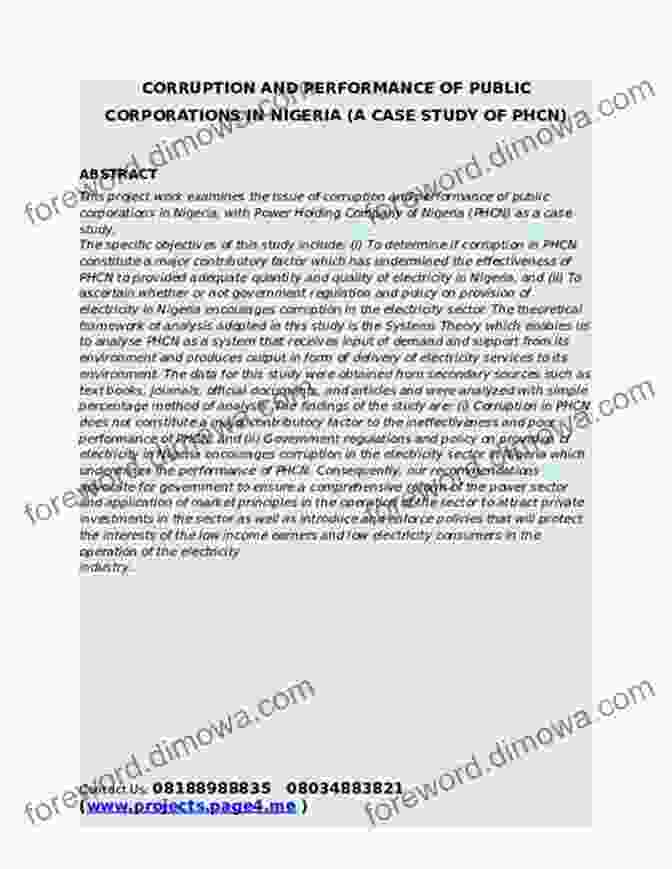Case Study of PHCN: Illuminating the Path to Nigeria's Energy Future

4.1 out of 5
| Language | : | English |
| File size | : | 841 KB |
| Text-to-Speech | : | Enabled |
| Enhanced typesetting | : | Enabled |
| Print length | : | 33 pages |
| Screen Reader | : | Supported |
| Paperback | : | 45 pages |
| Item Weight | : | 6.1 ounces |
| Dimensions | : | 8.5 x 0.11 x 11 inches |
Unveiling the Enigma of PHCN

The Power Holding Company of Nigeria (PHCN),a colossal entity that once held the reins of Nigeria's electricity sector, has been a subject of both intrigue and frustration. Its history is a tapestry woven with triumphs and tribulations, shaping an intricate story that has left an indelible mark on the nation's energy landscape. This comprehensive case study delves into the labyrinthine world of PHCN, shedding light on its origins, challenges, and the strategic roadmap that has guided its transformation.
A Journey Through Time: The Genesis of PHCN

The seeds of PHCN were sown in the early 20th century amidst a growing demand for electricity in Nigeria. In 1926, the colonial government established the Electricity Corporation of Nigeria (ECN),tasked with generating and distributing power to major cities. ECN's legacy extended to the establishment of thermal power stations in Lagos, Enugu, and Kano, laying the foundation for Nigeria's nascent power industry.
Following Nigeria's independence in 1960, ECN underwent a metamorphosis, transforming into the National Electric Power Authority (NEPA) in 1972. Under NEPA's stewardship, Nigeria's power sector witnessed significant expansion, with the construction of hydroelectric power plants such as the Kainji and Shiroro Dams. However, NEPA's growth was hampered by chronic underinvestment, inadequate maintenance, and rampant corruption, leading to persistent power outages and unreliable service.
Unraveling the Knotty Challenges: PHCN's Achilles Heel

PHCN, the successor to NEPA, inherited a plethora of challenges that plagued its operations. The company grappled with antiquated infrastructure, insufficient generation capacity, and a vast network of obsolete and inefficient distribution lines. Moreover, financial mismanagement, political interference, and a lack of transparency cast a long shadow over PHCN's performance.
The power generation sector faced severe constraints, with inadequate investments and poor maintenance leading to frequent breakdowns and limited capacity. Transmission and distribution networks were equally dilapidated, resulting in significant power losses and unreliable supply. The company's financial woes were compounded by a large customer base that had become accustomed to subsidized electricity, creating a vicious cycle of underinvestment and poor service.
A Beacon of Hope: PHCN's Reformation Journey

Recognizing the urgent need for reform, the Nigerian government embarked on a comprehensive restructuring and privatization process of the power sector in 2005. This historic move aimed to improve efficiency, increase generation capacity, and attract private investment to revitalize the industry. PHCN was unbundled into 18 successor companies, including generation, transmission, and distribution entities.
The privatization process, though complex and protracted, has injected a new wave of expertise and capital into Nigeria's power sector. Private investors have embarked on ambitious expansion and rehabilitation projects, leading to a gradual increase in generation capacity and a more stable power supply. The of independent power producers (IPPs) has fostered competition and encouraged innovation, contributing to the diversification of the generation mix.
Charting the Course: PHCN's Strategic Roadmap

As PHCN continues its transformative journey, a clear roadmap has been outlined to guide its evolution. The Power Sector Recovery Program (PSRP),launched in 2021, sets out a comprehensive strategy to address the sector's challenges and achieve sustainable growth. The roadmap encompasses key initiatives such as expanding generation capacity, improving transmission and distribution infrastructure, and reducing losses.
Furthermore, the government has prioritized the development of renewable energy sources, recognizing their potential to contribute to a cleaner and more sustainable energy mix. Nigeria has vast solar, wind, and hydro resources, and the harnessing of these renewable sources will play a crucial role in meeting the country's growing energy demand while reducing its carbon footprint.
A Brighter Future: PHCN's Legacy and the Road Ahead

The case study of PHCN provides valuable insights into the complexities of Nigeria's power sector. From its humble beginnings to its current state of transformation, PHCN's history is a testament to the challenges and opportunities inherent in providing reliable and affordable electricity to a growing population.
The strategic roadmap laid out by the government and the ongoing reforms within PHCN offer a beacon of hope for a brighter future. If successfully implemented, these initiatives have the potential to unlock Nigeria's vast energy potential, empower industries, improve livelihoods, and drive economic growth. PHCN's legacy will be defined by its ability to rise above its past challenges and become a catalyst for sustainable development in Nigeria.
4.1 out of 5
| Language | : | English |
| File size | : | 841 KB |
| Text-to-Speech | : | Enabled |
| Enhanced typesetting | : | Enabled |
| Print length | : | 33 pages |
| Screen Reader | : | Supported |
| Paperback | : | 45 pages |
| Item Weight | : | 6.1 ounces |
| Dimensions | : | 8.5 x 0.11 x 11 inches |
Do you want to contribute by writing guest posts on this blog?
Please contact us and send us a resume of previous articles that you have written.
 Book
Book Novel
Novel Page
Page Chapter
Chapter Text
Text Story
Story Genre
Genre Reader
Reader Library
Library Paperback
Paperback E-book
E-book Magazine
Magazine Newspaper
Newspaper Paragraph
Paragraph Sentence
Sentence Bookmark
Bookmark Shelf
Shelf Glossary
Glossary Bibliography
Bibliography Foreword
Foreword Preface
Preface Synopsis
Synopsis Annotation
Annotation Footnote
Footnote Manuscript
Manuscript Scroll
Scroll Codex
Codex Tome
Tome Bestseller
Bestseller Classics
Classics Library card
Library card Narrative
Narrative Biography
Biography Autobiography
Autobiography Memoir
Memoir Reference
Reference Encyclopedia
Encyclopedia Edward J Davison
Edward J Davison Ed L Scott
Ed L Scott Nadia Nicole
Nadia Nicole Augustine Sherman
Augustine Sherman Edward F Stanton
Edward F Stanton Dr Chikezie Kenneth Nwagu
Dr Chikezie Kenneth Nwagu Lesley Bown
Lesley Bown Wentz Wu
Wentz Wu Egidio Landi Degl Innocenti
Egidio Landi Degl Innocenti Edward Cox
Edward Cox Matt Johnston
Matt Johnston Ed Benjamin
Ed Benjamin Eduardo Mestre
Eduardo Mestre Dorothea Benton Frank
Dorothea Benton Frank Michael Wolliston
Michael Wolliston Eiji Funahashi
Eiji Funahashi Donna Freitas
Donna Freitas Dorothy Koomson
Dorothy Koomson William Bavone
William Bavone Dr Darya Hodaei
Dr Darya Hodaei
Light bulbAdvertise smarter! Our strategic ad space ensures maximum exposure. Reserve your spot today!
 Jan MitchellFollow ·4.3k
Jan MitchellFollow ·4.3k Jared NelsonFollow ·9k
Jared NelsonFollow ·9k Jack PowellFollow ·3.7k
Jack PowellFollow ·3.7k Galen PowellFollow ·3.2k
Galen PowellFollow ·3.2k Angelo WardFollow ·16.9k
Angelo WardFollow ·16.9k Ernest ClineFollow ·19.1k
Ernest ClineFollow ·19.1k David MitchellFollow ·17.6k
David MitchellFollow ·17.6k Cason CoxFollow ·5k
Cason CoxFollow ·5k

 Jacob Hayes
Jacob HayesBrave Son Elaine Wick: An Inspiring Tale of Triumph and...
Prepare to be captivated by...

 Dwight Bell
Dwight BellUnleash the Enchanted Journey: Discover "The Pride of the...
Embark on an Extraordinary...

 Winston Hayes
Winston HayesChess for Children: A Journey into the World of...
Unlock the Potential...

 Isaiah Price
Isaiah PriceDiscover the Enchanting West Coast with the West Coast...
Prepare to be captivated by...

 Shannon Simmons
Shannon SimmonsUnveiling the Enchanting Bond: Animals and the Human...
The Profound Connection: A Literary...
4.1 out of 5
| Language | : | English |
| File size | : | 841 KB |
| Text-to-Speech | : | Enabled |
| Enhanced typesetting | : | Enabled |
| Print length | : | 33 pages |
| Screen Reader | : | Supported |
| Paperback | : | 45 pages |
| Item Weight | : | 6.1 ounces |
| Dimensions | : | 8.5 x 0.11 x 11 inches |














